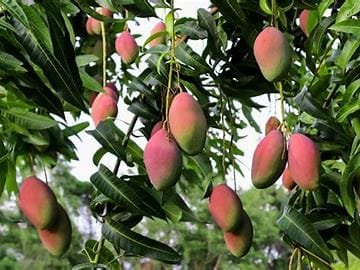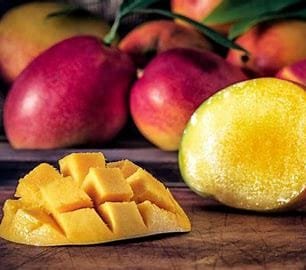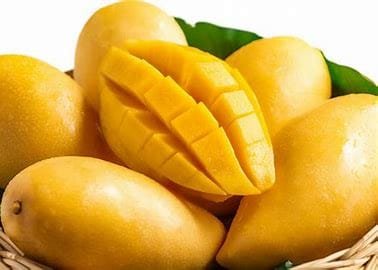One of the most popular tropical fruits in the world, the mango, is often referred to as the “king of fruits.” Originating from the Indian subcontinent and Southeast Asia, mangoes have been cultivated for over 4,000 years, prized for their sweetness of taste, nutritional value, and diverse uses in the culinary and cultural context. This fruit has some intriguing biological features that explain their suitability, productivity, and wide usage in agriculture.
Classification and Taxonomy

Mango belongs to the family Anacardiaceae, which comprises other economically important plants including cashew, Anacardium occidentale, and pistachio, Pistacia vera. The genus Mangifera comprises about 69 species, of which Mangifera indica is the most widely cultivated and documented. It is a dicotyledonous plant, meaning that its seeds comprise two embryonic leaves, or cotyledons. The mango tree is a long-lived species, with some living for over 300 years.
Morphology
Mango trees are tall, evergreen, and, in fact, grow up to 30 to 40 meters high, covered with dense, dome-shaped canopies. The extensive root system permits the plant to reach deep water sources within the soil so that they are drought-resistant and essential for growth in tropical and subtropical regions.
The leaves are simple, alternate in shape, and lance shaped, reaching as long as 30 centimeters in length. This leaf is commonly reddish or bronze when young and matures to dark green. These are leathery and waxy, which reduce water loss and make the plant tolerable to warmer climates. The bark of mango trees is thick and grayish brown, keeping the tree safe from all kinds of environmental stress.
Mango flowers are small, fragrant flowers that occur in panicles-branched clusters at the tips of branches. Each panicle may contain hundreds to thousands of flowers, but only some of these will develop into fruit.
Mango flowers are mainly yellowish white; some also possess male flowers that produce only pollen and bisexual flowers, which can set fruit.
Reproductive Biology
The plants are monoecious: male and bisexual flowers occur on the same tree, which increases their ability to reproduce. Pollination is through insects; flies and bees are common vectors, while wind is minor. The fruit ripens after successful pollination, taking about 100 to 150 days, depending on the variety and environmental conditions.
The mango is a drupe, stone fruit like peaches and cherries in a general sense. The fruit is fleshy, having a central big stone or pit with the seed. Mangoes come in varying sizes, shapes, and colors, from little, oval fruits of 150 grams up to huge, kidney-shaped fruits weighing over 2 kilograms. Depending on the variety, the skin may be green, yellow, red, or combinations of these colors. Flesh color usually varies from golden yellow to orange and characterizes the fruit for its sweetness and juiciness.
Varieties and Cultivation Over 1,000 varieties of mango are grown around the world, each with differences in its size, shape, color, and flavor.
Some of the most popular varieties are ‘Alphonso,’ ‘Haden,’ ‘Tommy Atkins,’ and ‘Kent.’ Though India is the largest producer of mangoes, the fruit grows in many tropical and subtropical regions like Southeast Asia, Africa, Central and South America, and the Caribbean.

Mangoes love a warm, dry climate and a long, frost-free period to ripen up.
Soil: Can grow deep and well-drained loamy soil slightly acidic to neutral. Trees are susceptible to cold damage and frost both to flowers and young fruit.
Mangoes are usually propagated through grafting to intensify desirable fruit qualities and resistance to disease. Using seeds for propagation would yield variable fruit traits. The grafting methods are preferred by commercial growers in order to have fruit sooner from tree maturity, generally at 3 to 6 years.
Physiology
Alternate bearing is one of the physiological characters of mango trees, in which the fruit load is heavy one year and negligible or even nil the following year. Such behavior may be owed to some changing environmental factors, nutrient availability, or hormonal fluctuations within the tree itself. This phenomenon is very important to understand and consequently manage to ensure consistent yields in mango orchards.
The fruit is highly sugary, with fructose, glucose, and sucrose that make mango sweet. Vitamin A and C, fiber, and even antioxidants, beta-carotene, can be found here. These nutrients, of course, make mangoes a great treat and healthy addition to the diet.
Adaptations and Growth Habits
One of the notable characteristics of a mango tree is the ability to grow under different environmental conditions. The extensive root system confers the potential ability of the tree to tolerate drought and to access deep water. The waxy cuticle on the leaves further reduces water loss, making the plant drought resistant.
Mango trees have a unique phenological cycle very much dependent on temperature and rainfall; they flower in the dry season, and their fruits usually ripen at the onset of the rainy season. This coincidence or overlap would help to minimize factors of disease and pest infestation that might specifically attack fruits at stages of critical growth. The timing of flowering and fruit set may be affected by inter-regional variations and environmental stresses such as temperature fluctuation and water availability.
Pests and Diseases:
Mango production is not without problems. These pests include mango fruit flies, mealybugs, and aphids. These diseases destroy a large portion of the fruit, causing yields to be lost. Fungal diseases such as powdery mildew, anthracnose, and mango malformation can also cause serious impacts. Practices regarding healthy orchard management should employ several ways, including using resistant varieties, proper timing for pesticide application, and cultural techniques such as pruning and thinning.
Conclusion

Mango is not a fruit in its own right but a biologically important, rich, and fascinating organism in tropical agriculture. With its wide adaptability, nutritional value, and cultural importance, mango is a crop of paramount importance for millions of people on this globe. From its complex reproductive biology down to the toughness of its endurance, the mango tree is a true marvel of nature, which both humans and wildlife find sustenance and delight in. Very importantly, its further cultivation, study, and conservation will help in the sustainable reproduction of this “king of fruits” by many generations of man.



